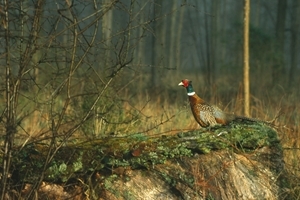 This study examined the effect of pheasant release and game management on Exmoor, for woodland plants, mosses and lichens, conifer forests, game crops, other crops and breeding birds in hedgerows. Exmoor is an area with high shooting activity and a large number of released birds. This study looked at a representative group of seven large shoots covering 40,000 acres in total on the southern Exmoor fringes, to examine the environmental impacts. It gives us a broader view of the possible effects on the area and is the first time many have been studied.
This study examined the effect of pheasant release and game management on Exmoor, for woodland plants, mosses and lichens, conifer forests, game crops, other crops and breeding birds in hedgerows. Exmoor is an area with high shooting activity and a large number of released birds. This study looked at a representative group of seven large shoots covering 40,000 acres in total on the southern Exmoor fringes, to examine the environmental impacts. It gives us a broader view of the possible effects on the area and is the first time many have been studied.
Key points
- Hedgerows on game estates had roughly twice as many breeding birds, and three times as many of seed-eating resident species, than hedgerows on reference areas without game management.
- Conifer woods managed for game had improved biodiversity, with a more open canopy, more grass and bracken, and more woodland birds.
- Game crops made up almost 4% of the cropped area, consisted of 13 different species or mixes and contributed to a more mixed landscape, with a greater variety of crops and smaller fields than would be seen without game management.
- Pheasant release pens had more bare ground, and fewer woodland herbs and ferns.
- There was less moss, lichen and similar species on trees in pheasant release pens, and in the surrounding woodland.
- Shooting estates of various sizes were studied, looking at five factors that might be affected. Pheasant releasing and game management had positive effects on three of these and negative effects on two.
- There are other possible impacts which have not yet been studied, and more understanding is needed for some of those which have.
Background
Pheasant releasing is common across the UK, to provide birds for shooting in the winter. They are released into woodland pens in late summer, where they adjust to the habitat, grow and gradually disperse across the countryside before the shooting season begins in October. There is a lot of debate about releasing large numbers of birds into woodland, and the effect it might have on the plants, animals and wider environment. Lots of research has been done and these studies show that, in general, the presence of the birds themselves in the release pens can have a negative effect on plants and soils.
In the wider area around the release pens, a positive effect is often found, as a result of the woodland management that is done in areas that are used for game shooting. This includes encouraging shrubs, coppicing, and keeping clearings and tracks open, which allows light into the wood, which is good for butterflies, birds and other plants. Shoot management guidelines and the Code of Good Shooting Practice have been developed to help shoot managers minimise the negative effects which can be seen, whilst keeping the positive ones.
These findings have been shown across the country, but there is a particularly high level of shooting activity in the Exmoor area, and a high number of birds are released, although we do not know how many birds were released at the study sites. There are concerns about whether larger shoots may have more of an effect on the local habitat as they release more birds. This study was done to find out what effect pheasant releasing was having on the habitats and environment of Exmoor estates.
The study overall
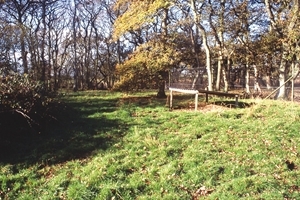 This study looked at the effect of pheasant releasing across southern Exmoor. It ran for three years from 2015-17, on seven shooting estates and a variety of suitable reference areas. These reference sites were not managed for game and were used as matched comparison areas for the pheasant release sites, allowing the scientists to study the effect of the pheasant release. They were chosen in areas of nearby farmland, the Exmoor National Park, or National Trust estates, depending what was most appropriate. All seven shooting estates had professional gamekeepers managing the pheasant release areas, and they ranged in size including smaller shoots (total area 1,000 acres) and very large ones (covering 14,000 acres). The GWCT is grateful to all sites that participated in this important study.
This study looked at the effect of pheasant releasing across southern Exmoor. It ran for three years from 2015-17, on seven shooting estates and a variety of suitable reference areas. These reference sites were not managed for game and were used as matched comparison areas for the pheasant release sites, allowing the scientists to study the effect of the pheasant release. They were chosen in areas of nearby farmland, the Exmoor National Park, or National Trust estates, depending what was most appropriate. All seven shooting estates had professional gamekeepers managing the pheasant release areas, and they ranged in size including smaller shoots (total area 1,000 acres) and very large ones (covering 14,000 acres). The GWCT is grateful to all sites that participated in this important study.
The scientists studied which plants were found on the ground, in what numbers, and the mosses, lichens etc found on trees in the surrounding woods. They measured the type and number of bird species in woods and hedgerows, and looked at the game crops nearby – how much land was used for these, the layout of the crops and which species were planted.
The study was divided into five sections, all of which pheasant release nearby might have affected:
In woodland:
- Plants on the ground in broadleaf woodland
- Mosses, lichens and similar species in broadleaf woodland
- Conifer woods – birds seen, plants and shrubs found and canopy density
On farmland:
- Game crop plots – the amount planted, species chosen and arrangement in the landscape
- Breeding birds in hedgerows
What they did and what they found: in detail
Ground plants in deciduous woods
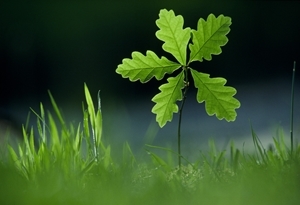 Other studies have found that woodland plants can be affected by pheasant release pens, depending on the stocking density – i.e. number of birds for the area. Pheasants scratch and trample the ground, and their droppings add nutrients to the soil that would not otherwise be there, both of which change the mix of plants that grow. However, the woodland management of pheasant release woods will also affect the plants that grow. Management to open the canopy lets more light into the wood, so shade-loving species will give way to those preferring a lighter environment, and the changes are probably caused by all these factors together.
Other studies have found that woodland plants can be affected by pheasant release pens, depending on the stocking density – i.e. number of birds for the area. Pheasants scratch and trample the ground, and their droppings add nutrients to the soil that would not otherwise be there, both of which change the mix of plants that grow. However, the woodland management of pheasant release woods will also affect the plants that grow. Management to open the canopy lets more light into the wood, so shade-loving species will give way to those preferring a lighter environment, and the changes are probably caused by all these factors together.
In this part of the study, 26 study plots were used, across seven shooting estates and four national park sites, in the following areas:
- Inside a release pen
- Outside the release pen, within the same wood
- In nearby woods without a release pen
- At four national park woods
At each plot, six sampling points were chosen randomly within 100m of a central point. At each sampling point, two areas of two square metres each were surveyed. 312 vegetation surveys were completed in this section of the study alone. Each one identified and recorded the species present, and how much of the ground was covered by each species.
Overall, the number of different species between pheasant release pens and reference sites were the same, but the amount of ground covered by these plants was lower for some groups of species. Inside release pens, 40% of the ground was bare, compared to 10% outside release pens in game woods and also 10% in national park woods. There were fewer woodland herbs, 15% in pens compared to 30% outside pens and in national park woods. On control plots outside the pen, twice as many fern species and three times as much fern coverage were found in woods with pens than woods on the same estate without pens. There was five times less fern cover in release pens compared to control plots within the same woods. Although these species were still present, they were found less often. These results are broadly similar to those of other work looking at woodland ground in and around release pens.
In general, these effects were confined to the pen itself, and did not spread into the surrounding woodland, but the results for ferns did affect the whole wood. Overall, similar ferns were found in estate controls as in national park woods.
When the control areas on shooting estates were combined (those in release woods and those in other woods), no differences were found between these estate controls and those on national park sites.
Mosses and lichens
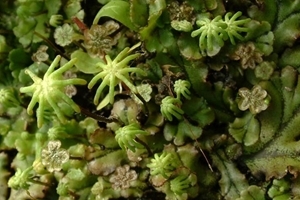 This part of the study looked at both bryophytes and lichens on trees, as well as mosses on the ground. Bryophytes are small plants that grow in moist areas, and do not produce flowers or seeds. The term includes mosses, and a group of plants called liverworts. These plants are sometimes studied as indicators of air quality, and they can be affected by air pollution. Woodlands in the west of England in particular usually have good air quality and have an important mix of bryophytes and lichens. Overall, 32 species of lichen, seven moss species and four liverworts were found in this study. It is important to find out whether these are being affected by pheasant releasing. As well as adding nutrients to the soil, pheasant droppings may also enrich the air, for example with nitrogen, and this could impact sensitive plants like mosses, liverworts or lichens.
This part of the study looked at both bryophytes and lichens on trees, as well as mosses on the ground. Bryophytes are small plants that grow in moist areas, and do not produce flowers or seeds. The term includes mosses, and a group of plants called liverworts. These plants are sometimes studied as indicators of air quality, and they can be affected by air pollution. Woodlands in the west of England in particular usually have good air quality and have an important mix of bryophytes and lichens. Overall, 32 species of lichen, seven moss species and four liverworts were found in this study. It is important to find out whether these are being affected by pheasant releasing. As well as adding nutrients to the soil, pheasant droppings may also enrich the air, for example with nitrogen, and this could impact sensitive plants like mosses, liverworts or lichens.
Surveying these species requires specific and expert identification skills, so a specialist contractor was employed. At each of the 312 random sampling sites mentioned earlier, a 40x50cm square on the ground was also surveyed for bryophytes and lichens. The closest suitable tree was chosen and four surveys of 50x10cm were done around the trunk, 1.5m above ground.
34 different moss species were found on the ground, with no difference in the number and mix of moss species between release pens and other sites on the shooting estates – either reference areas in the same wood, or in other woods without pens. There was also no difference between the number of moss species in shooting estates and national park surveys, but mosses covered over 20% of the ground on national park sites, and less than 15% of the ground on shooting estates.
When the scientists looked at mosses and bryophytes growing on trees, the number of species and amount of each species was the same between shooting estates and national park sites. However, when they looked more closely at the different sites within shooting estates, they found 30-50% fewer liverwort species and less coverage in woods with a release pen, compared to woods without a release pen. Woods with a release pen had around half the amount of liverworts compared to woods without a pen. There were also about 25% more moss species found on trees in woods without a release pen compared to release woods, either inside or outside the pen. No differences were found for lichens. In general, national park woods had similar amounts of bryophytes and lichens as woods on game estates that contained no release pen.
Conifer woods
There are large areas of conifer woodland around Exmoor; much of it was planted in the 1970s and is now relatively mature. Many game managers use areas of conifer woodland on their shoot, and this part of the study looked at the plants, shrubs and structure of conifer woods that were managed for shooting compared to those that weren’t. Birds were also counted in the study woods.
26 conifer woods were selected from maps across four shooting estates. In each of these woods, 20 surveys were carried out at random points. At each of these 520 points, the scientists recorded which plant species were present and how much space each of these covered in a square metre of ground, as well as the shrubs and trees within a 10m square and the birds they saw or heard whilst there.
The scientists found that there tended to be more shrubs and wider spacing between trees in game-managed woods, but the differences were not significant in statistical tests. This means that, although more shrubs and wider spacing was seen in game woods, the difference was not great enough for us to be sure it did not occur by chance. However, the differences were large. For example, of the ten-metre squares surveyed, in game woods almost two thirds had shrubs, compared to just over one third in non-game woods. The canopy was more open in game woods, as might be expected from the higher level of woodland management that occurs here. The woods all had a fairly diverse mix of tree species, rather than being entirely made up of one species, and game management did not affect this. There was more bracken and grass in game woods, but again the differences were not statistically significant (bracken: game woods over 80% compared to non-game woods around 55%; grass: game woods almost 40% compared to non-game woods less than 30%).
Bird encounters were also recorded – this means either birds that were seen, or those that were heard during the survey visit of approximately two hours. Significantly more birds were encountered in game woods. This was true of songbirds (average 13 in game woods versus 7.5 in non-game woods), woodland birds (4 vs 2.5) and all birds overall (18 vs 10).
Game cover crops
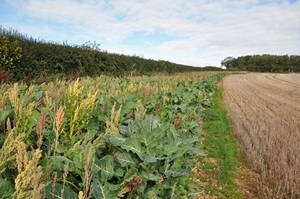 This part of the study aimed to understand the game cover crops maintained by shooting estates, how much is present, of which species, and how it is laid out in the landscape. On six shooting estates, a questionnaire survey was carried out with a follow-up site visit.
This part of the study aimed to understand the game cover crops maintained by shooting estates, how much is present, of which species, and how it is laid out in the landscape. On six shooting estates, a questionnaire survey was carried out with a follow-up site visit.
There were 175 game crop plots on the six estates studied – an average of 29 plots per estate. The questionnaire result showed that the average size of game crop blocks, which may be made up of several plots next to each other, was eight acres (just over three hectares), and the plots had been used for game crops for between 5 and 25 years. On average these plots covered 3.7% of the cropped area, ranging from 3% to 10% on different estates, and consisted of 13 different crops, including several crop mixes. The most common were maize and kale, followed by wild bird seed mixes and many others such as reed canary grass, artichokes, chicory, mustard and linseed.
When looking at the arrangement of game crops, the scientists recorded where these plots are in relation to fields, hedgerows, woodland etc and whether the layout is in strips or blocks. Although there are some common features – for example, the plots often have open strips called ‘headlands’ around the edges and ‘rides’ through the middle, half are next to woodland and almost half border a hedgerow – overall is it a mixed picture, the game plots having various different characteristics. This variety across the landscape is rare in modern farming.
To look into this in more detail, digital maps were used on which the fields and their contents were accurately plotted for a subset of three of those six surveyed estates. On these three estates, the average size of an individual plot was 4.4 acres (1.8 hectares), and when looking at the larger blocks, made up of game crops next to each other, the average block size was 7.2 acres (2.9 hectares).
Farming maps from the late 1960s were then used to compare the changes in landscape from the era before the intensification of farming to the farmed environment today, looking at the whole cropped area of those three estates with digital cropping maps. Maps from the 1960s were compared with both the existing cropping plan, and also to a theoretical plan of what the sites may be like if the crops planted for pheasants were removed and replaced with crops that would likely be seen in their place. The addition of game crops to the countryside makes today’s farmed landscape more similar to that of the 1960s than otherwise is the case in modern farming. This means that the crops are more mixed, with more diversity and generally smaller field sizes for those fields that are not grass.
Hedgerow birds
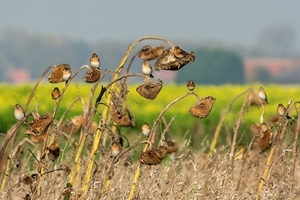 This section looked at whether the presence of game crops near to hedgerows had any effect on the number and type of songbirds in those hedgerows in spring. Although we know that game crops themselves can attract various bird species in winter, we don’t know if that means that more birds breed nearby in spring.
This section looked at whether the presence of game crops near to hedgerows had any effect on the number and type of songbirds in those hedgerows in spring. Although we know that game crops themselves can attract various bird species in winter, we don’t know if that means that more birds breed nearby in spring.
The scientists counted breeding birds in hedgerows on three game estates and three suitably matched reference sites on a large National Trust property that had no shooting. All of these sites were mainly grassland, with some arable, but the game estates also had game crops. All birds seen or heard in the hedgerow sites were recorded, but not those flying overhead or in adjacent fields. The size of the hedgerow was measured, as well as the distance to the nearest woodland.
28 different species were recorded in this part of the study. The average number of birds per kilometre of hedgerow on game estates was 12, twice as high as on the reference sites, which had 6 per km. When looking in more detail and looking only at the seed-eating species such as blackbirds, blue tits, bullfinches and chaffinches, there were on average almost three times as many birds per kilometre of hedgerow on game estates (8) compared to non-game sites (3). The study also showed that within shooting estates, hedges close to game crop plots (closer than 200m) had more breeding songbirds than hedges further away (more than 400m).
What does this all mean?
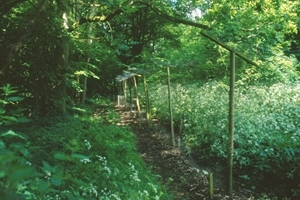 Inside release pens, the pheasants themselves seem to affect vegetation, possibly by adding nutrients to the ground in their droppings, as well as the physical effect of scratching at the ground while looking for food and eating plant material. We do not know the stocking densities of these release pens, but the changes seen here are similar to those seen elsewhere where pens are stocked at average levels, which still tend to exceed the recommended densities.
Inside release pens, the pheasants themselves seem to affect vegetation, possibly by adding nutrients to the ground in their droppings, as well as the physical effect of scratching at the ground while looking for food and eating plant material. We do not know the stocking densities of these release pens, but the changes seen here are similar to those seen elsewhere where pens are stocked at average levels, which still tend to exceed the recommended densities.
Where GWCT guidelines are followed and pens are stocked at below 1,000 birds per hectare (or 700 on ecologically sensitive sites), these changes can be reduced or avoided whilst the benefits of game management are retained. These guidelines have been incorporated into the Code of Good Shooting Practice. Although we believe that stocking densities have fallen in recent years, this reinforces the importance of shoots keeping to the recommended guidelines.
The effect of release pens on mosses and liverworts that was seen in this study is interesting, and its cause is not known. It may be that the pheasants increase the amount of nitrogen in the air, which is known to slow the growth of these plant groups. It may be because game woods have more light at ground level. These findings are important, because mosses and liverworts have never been studied before when looking at the effect of pheasant release, and this is the first evidence for a possible effect. We do not know either how far up the trees into the canopy, or how far out from the release pen this effect might extend, or whether it would also be reduced or avoided with lower stocking densities and these would be interesting to investigate.
The presence of a large area of game cover crops, particularly because of the range of species and mixes present, will bring benefits to many species through the winter. Many studies have shown that such crops are used by farmland wildlife, for example songbirds, butterflies and bumblebees. One benefit of the sites in this study is the large size of the game crops present. In general, game crop plots larger than around 1 hectare are more beneficial to birds, and in this study the large estates had game crops that were on average much bigger than this. The open areas around and through game plots are beneficial to butterflies, and the variety in placement provides habitat that is more suited to different bird species across the estate.
The addition of game cover crops to the farmed landscape on these estates has the effect of making it more similar to the environment in the 1960s, when crops were more diverse, fields were smaller and hedgerows more common. Overall, it is thought that these changes have been detrimental to farmland wildlife, as a more mixed habitat can provide for more species at different times of year. In regions that are mainly grassland, such as some of our study areas, game crops can be the only source of seed in winter.
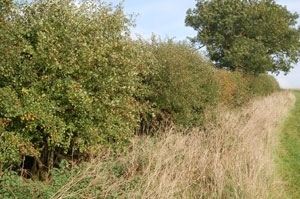 This is supported by the findings on hedgerows in this study. Hedgerows that are closer to game crops contain more birds than those further away, and hedgerows on game estates have more breeding birds than those without game management. This applies only to the birds that spend the winter here, but not to those that migrate here from their winter feeding sites, as the game crops are no longer present when they arrive in time to breed. It may be that over-winter survival is better, or that birds just stay in the area as a result of game crops providing food nearby. Overall, though, the numbers recorded in this study are lower than might be expected on a mixed farming environment elsewhere, which may be because the area is predominantly grassland, which provides limited food for seed-eating birds in winter. There are other possible effects of releasing, which the study did not look at.
This is supported by the findings on hedgerows in this study. Hedgerows that are closer to game crops contain more birds than those further away, and hedgerows on game estates have more breeding birds than those without game management. This applies only to the birds that spend the winter here, but not to those that migrate here from their winter feeding sites, as the game crops are no longer present when they arrive in time to breed. It may be that over-winter survival is better, or that birds just stay in the area as a result of game crops providing food nearby. Overall, though, the numbers recorded in this study are lower than might be expected on a mixed farming environment elsewhere, which may be because the area is predominantly grassland, which provides limited food for seed-eating birds in winter. There are other possible effects of releasing, which the study did not look at.
This study revealed some interesting findings regarding the impact of game management on the habitats and species of Exmoor. It is particularly relevant to note that, despite some of these estates working on a large scale, with suitable management the positive effects can be retained despite, or sometimes perhaps because of, those increases in scale. Large areas of game cover crop of different varieties across the landscape are possible on a large estate in a way that may not be feasible on a small or medium sized shoot, and income from the shoot can provide resources for beneficial woodland management. Regardless of size, shoots should adhere to releasing guidelines and the Code of Good Shooting Practice for maximum benefits.